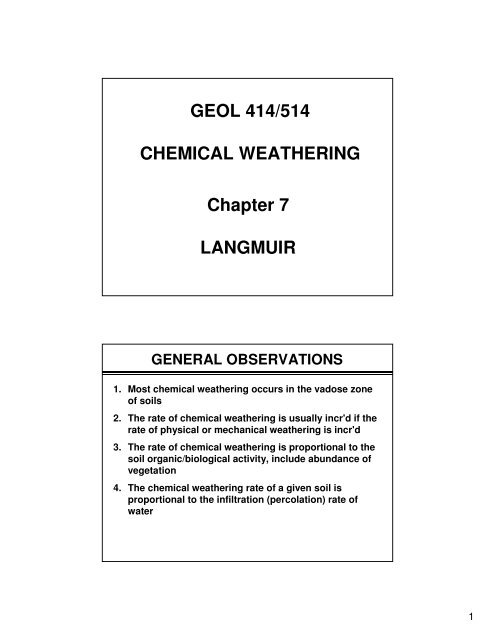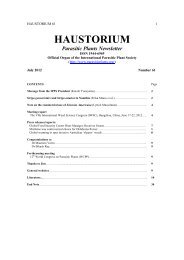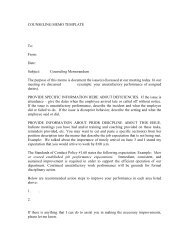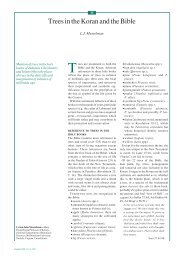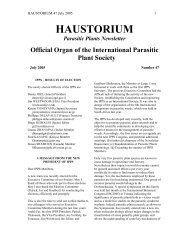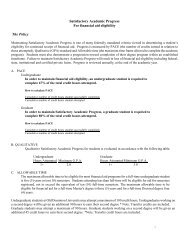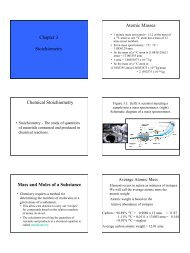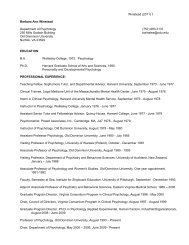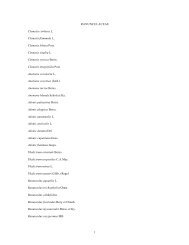Chapter 7 LANGMUIR GEOL 414/514 CHEMICAL WEATHERING
Chapter 7 LANGMUIR GEOL 414/514 CHEMICAL WEATHERING
Chapter 7 LANGMUIR GEOL 414/514 CHEMICAL WEATHERING
You also want an ePaper? Increase the reach of your titles
YUMPU automatically turns print PDFs into web optimized ePapers that Google loves.
<strong>GEOL</strong> <strong>414</strong>/<strong>514</strong><br />
<strong>CHEMICAL</strong> <strong>WEATHERING</strong><br />
<strong>Chapter</strong> 7<br />
<strong>LANGMUIR</strong><br />
GENERAL OBSERVATIONS<br />
1. Most chemical weathering occurs in the vadose zone<br />
of soils<br />
2. The rate of chemical weathering is usually incr'd if the<br />
rate of physical or mechanical weathering is incr'd<br />
3. The rate of chemical weathering is proportional to the<br />
soil organic/biological activity, include abundance of<br />
vegetation<br />
4. The chemical weathering rate of a given soil is<br />
proportional to the infiltration (percolation) rate of<br />
water<br />
1
GENERAL OBSERVATIONS<br />
5. The rate of chemical weathering inc with inc temp<br />
6. Chemical weathering generally involves the attack of<br />
H 2O & assoc acidity, & atmos O 2 (oxid'n) on P.M.'s<br />
7. Compared with the parent rock, mineral products of<br />
weathering are usually more hydrated (as clays), have<br />
lower metal cation conc's relative to Al & Si (clays &<br />
qtz), are oxidized (Fe +3 oxyhydroxides), or are chem<br />
ppts such as carbonates or evaporites<br />
8. Dissolved products of weathering include major<br />
cations & anions in natural waters & dissolved silica<br />
GENERAL OBSERVATIONS<br />
• Problem in determining detailed weathering reactions<br />
• Need chemical analysis at different stages of<br />
weathering<br />
• Difficult to know if different stages sampled had same<br />
original composition<br />
• Also need reference mineral or element; one that<br />
weathers little<br />
• Must make several key assumptions<br />
2
COMMON <strong>WEATHERING</strong> PRODUCTS<br />
ROCK <strong>WEATHERING</strong><br />
(from Brownlow)<br />
3
ROCK <strong>WEATHERING</strong> - 2<br />
ROCK <strong>WEATHERING</strong> - 3<br />
(I) (II) (III) (IV)<br />
4
CHANGES IN ROCK COMPOSITION<br />
• Expression of conc’s as oxides<br />
- started when it was thought that<br />
most forms were oxides<br />
- still convenient<br />
- most minerals contain<br />
significant amounts of oxygen<br />
- comp. sums to 100%<br />
CHANGES IN ROCK COMPOSITION<br />
Use of Al as reference element:<br />
- oxide is very insoluble<br />
- Al 2O 3 shows greatest apparent<br />
increase in weathered materials<br />
- of major elements, Al is least<br />
abundant in stream & ground waters<br />
- but not absent from these waters<br />
5
CALCULATION OF LOSSES & GAINS<br />
<strong>WEATHERING</strong><br />
Al as Al 2O 3<br />
is basis of<br />
weathering<br />
calculations<br />
6
COMPONENT<br />
VARIATION<br />
UPON<br />
<strong>WEATHERING</strong><br />
MINERAL<br />
VARIATION<br />
UPON<br />
<strong>WEATHERING</strong><br />
(from Brownlow)<br />
(from Brownlow)<br />
7
SOLUBILITY OF SILICA<br />
(from Brownlow)<br />
AGENTS OF <strong>CHEMICAL</strong> <strong>WEATHERING</strong><br />
• Agents:<br />
Moisture (H 2O)<br />
O 2<br />
CO 2<br />
Organic acids<br />
• Types of reactions:<br />
• Solution<br />
NaCl + H 2O → Na + + Cl - + H 2O<br />
• Hydration<br />
CaSO 4 + 2H 2O → CaSO 4 • 2H 2O<br />
8
<strong>CHEMICAL</strong> <strong>WEATHERING</strong><br />
Types of reactions, cont:<br />
• Carbonate weathering<br />
key is CO 3 -2 + H + HCO 3 -2 (stable)<br />
• Oxidation<br />
• Fe and Mn compounds<br />
• Other sulfides<br />
• most decomposition reactions<br />
occur in steps - many not yet<br />
clearly understood<br />
<strong>CHEMICAL</strong> <strong>WEATHERING</strong> -2<br />
Oxidation of pyrite:<br />
Oxidation of S:<br />
2FeS 2 + 7O 2 + 2H 2O → 2FeSO 4 + 2H 2SO 4<br />
Oxidation of Fe:<br />
4FeSO 4 + O 2 + 2H 2SO 4 → 2Fe(SO 4) 3 + 2H 2O<br />
Hydrolysis of Fe +3 :<br />
Fe(SO 4) 3 + 6H 2O → 2Fe(OH) 3(s) + 3H 2SO 4<br />
9
<strong>CHEMICAL</strong> <strong>WEATHERING</strong> - 3<br />
• Hydrolysis (of silicates)<br />
• Most silicates weather by hydrolysis<br />
• Mg 2SiO 4 + H 2CO 3 → 2Mg +2 + 4HCO 3 -2 + H4SiO 4<br />
• Silicic acid is weaker than carbonic acid and<br />
is very weakly ionized<br />
• Weathering scheme is very complex due to<br />
the presence of several different cations<br />
in silicates<br />
<strong>CHEMICAL</strong> <strong>WEATHERING</strong> - 4<br />
• Alumino-silicates weathering clay minerals<br />
• Hydrolysis of silicates increases basicity of<br />
system - OH - or HCO 3 - ions produced<br />
• Constraint of pH: (keeps pH 9.0)<br />
• H 2O + SiO 2 (qtz) + OH - → H 3SiO 4 - K=10 0.4<br />
• H 4SiO 4 (aq) + OH - → H 3SiO 4 - + H2O K=10 4.2<br />
10
THE SOIL<br />
Weathering of the Earth’s crust:<br />
raw materials for soil formation<br />
Igneous rocks<br />
Sedimentary rocks<br />
Metamorphic rocks<br />
Soil has three (four) components:<br />
Mineral (inorganic)<br />
Organic matter<br />
Pore spaces (air & water)<br />
THE SOIL<br />
11
Soil Composition:<br />
Mineral soil particles<br />
• Sand - (coarse particles):<br />
50 to 2000 micrometers (µm)<br />
diameter<br />
• Silt - (medium sized particles):<br />
2 to 50 µm diameter<br />
• Clay - (fine particles):<br />
< 2 µm diameter<br />
RELATIVE ABUNDANCE OF PRIMARY<br />
AND SECONDARY MINERALS<br />
TIME<br />
12
SOIL COMPOSITION<br />
Organic Component:<br />
• Living soil organisms<br />
Invertebrates<br />
Bacteria & Fungi<br />
Important function as decomposers<br />
• Plant roots<br />
Major portion of soil biomass<br />
• Decomposing organic matter (OM)<br />
Food source for soil organisms<br />
• Humus (highly decomposed, colloidal, OM)<br />
Most chemically active organic component<br />
SOIL COMPOSITION<br />
Pore Spaces:<br />
• Approximately 50% of soil volume<br />
• Air or water depending upon conditions<br />
• Higher conc of CO 2, H 2O vapor that atmos air<br />
• Importance of O 2 diffusion to roots<br />
• Clay soils:<br />
Small pores hold water tightly<br />
Air movement is limited<br />
• Sandy Soils:<br />
Large pores, rapid water drainage; little remains<br />
Free movement of air, gasses<br />
13
SOIL COMPOSITION:<br />
Soil Water<br />
• Saturation:<br />
- flooding rain, irrigation<br />
• Field capacity:<br />
- moisture content when water has drained away<br />
due to gravity forces<br />
- clay soils hold more water than sandy soils<br />
• Permanent wilting point:<br />
- soil is so dry plants cannot remove remaining<br />
water<br />
- no water movement in soil at this point<br />
IMPORTANT SOIL CHARACTERISTICS<br />
• Soil texture and clay minerals<br />
• Soil structure<br />
• Soil water<br />
• Soil atmosphere<br />
• Soil pH<br />
• Salinity<br />
14
The major soil<br />
textural<br />
classes are<br />
defined by the<br />
percentages of<br />
sand, silt, and<br />
clay according<br />
to the heavy<br />
boundary lines<br />
shown on the<br />
textural<br />
triangle.<br />
SOIL TEXTURAL CLASSES<br />
SOIL STRUCTURE AND<br />
PERCOLATION OF WATER<br />
15
IMPORTANT PHYSICO-<strong>CHEMICAL</strong><br />
PROPERTIES<br />
• Cation sorption and exchange<br />
• Cation replacement order<br />
• Cation adsorption vs desorption<br />
• Ion exchange equation<br />
• Anion adsorption<br />
• Water adsorption<br />
• Soil pH - acid or alkaline - affects ion exchange and<br />
soil reactions<br />
FACTORS INFLUENCING SOIL<br />
FORMATION<br />
1. Parent materials (geologic or organic precursors<br />
to the soil<br />
2. Climate (primarily precipitation & temperature)<br />
3. Biota (living organisms, especially native<br />
vegetation, microbes, soil animals & humans<br />
4. Topography (slope, aspect & landscape position)<br />
5. Time (the period of time since the parent materials<br />
became exposed to soil formation factors)<br />
16
A Horizon<br />
Organic rich<br />
Highest organism<br />
activity<br />
E Horizon<br />
Zone of leaching,<br />
eluviation<br />
B Horizon<br />
Weathered,<br />
Accumulation of<br />
Clays, oxides<br />
C Horizon<br />
Parent Material;<br />
May be multiple<br />
layers<br />
R Horizon<br />
Bedrock<br />
In Hampton Roads:<br />
2000 ft deep<br />
ALLUVIAL<br />
SOIL<br />
Note many<br />
layers of very<br />
different types<br />
of parent<br />
material<br />
PRIMARY SOIL HORIZONS<br />
From<br />
Maryland<br />
Note<br />
buried<br />
A and B<br />
Horizons<br />
17
AGE OF SOIL<br />
• Soil age is based on development of key or<br />
“diagnostic” horizons<br />
• Soil age not based on chronologic age<br />
• Immature - few and/or weakly developed<br />
horizonation (weathering)<br />
• Mature - maximum (or near) number of<br />
horizons with well defined char’s and<br />
extensive weathering<br />
SOIL CLASSIFICATION<br />
• Pedocal - high amounts of CaCO 3 and/or<br />
CaSO 4 in profile; occur in lowrainfall<br />
areas; high soil pH<br />
• Pedalfer - high amounts of Fe & Al<br />
compounds in profile; extensive profile<br />
leaching; low soil pH; > 25 in. annual<br />
precip’n<br />
18
SOIL CLASSIFICATION<br />
USDA Soil Classification - Table 7-4<br />
Soil Orders:<br />
Entisols<br />
Inceptisols<br />
Mollisols<br />
Alfisols<br />
Ultisols<br />
Oxisols<br />
weathering<br />
Vertisols<br />
Aridisols<br />
Spodosols<br />
Histisols<br />
Andisols<br />
EXTREME SOIL <strong>WEATHERING</strong><br />
End products of soil weathering:<br />
• Laterites - contain hematite, goethite,<br />
gibbsite, boehmite, rarely diaspore<br />
• ferruginous laterite - mostly<br />
hematite & goethite<br />
• aluminous laterite - mostly gibbsite,<br />
boehmite & diaspore<br />
19
CRUSTAL <strong>WEATHERING</strong> AND CLIMATE<br />
IMPORTANT SOIL PROPERTIES<br />
Many soil properties are important in the field<br />
of environmental geochem:<br />
• Mineralogy<br />
• Organic matter content (%OM)<br />
• Cation exchange capacity (CEC)<br />
• Porosity/permeability<br />
• Texture<br />
• pH<br />
20
QUARTZ SOLUBILITY<br />
• Silica and the silicates comprise ~90% of earth’s crust<br />
• SiO 2 (silica): quartz, amethyst, agate, opal<br />
• Different polymorphs of silica:<br />
α-quartz, β-quartz, tridymite, cristobalite, stishovite<br />
and coesite plus amorphous forms<br />
• Chert is an impure form of microcrystalline α-quartz,<br />
often described as chalcedony<br />
• Opal is amorphous silica containing water<br />
• Many studies have been conducted on the aqueous<br />
transport of silica<br />
• α-quartz is a very common form and we’ll examine prop’s<br />
Solubility of αquartz<br />
&<br />
amorphous silica<br />
Solubility of two<br />
forms are orders<br />
of magnitude<br />
apart<br />
Note variability of<br />
experimental<br />
results (symbols)<br />
QUARTZ SOLUBILITY - 2<br />
21
QUARTZ SOLUBILITY - 3<br />
• The solubility of other forms of other forms of silica falls<br />
between these two curves<br />
• At equilibrium, at pH 9), the two right-hand terms of Eq 4-6<br />
(above) become important<br />
• Note the change in solubility as a function of pH (Fig 7-7)<br />
22
QUARTZ SOLUBILITY - 5<br />
KAOLINITE SOLUBILITY<br />
• A clay mineral formed by weathering & hydrothermal<br />
alteration of other aluminosilicates, esp feldspars<br />
• [Al 2 Si 2 O 5 (OH) 4 ] - generally considered the end member<br />
of the phyllosilicates<br />
Pyrophyllite – [Al 2 Si 4 O 10 (OH) 2 ],<br />
“ideal” 1:1 clay with no charge<br />
Gibbsite – [Al(OH) 3 ]<br />
23
KAOLINITE SOLUBILITY - 2<br />
Points A & B<br />
represent changes<br />
in solution comp’n<br />
over a 1237 day<br />
time period.<br />
Note axes units;<br />
this is known as an<br />
activity-activity<br />
diagram.<br />
Kaolinite stability<br />
relative to Al<br />
species & H +<br />
Note shape of<br />
curve, pH & m Al+3<br />
KAOLINITE SOLUBILITY - 3<br />
(Fig 4-7)<br />
(Fig 4-8)<br />
24
KAOLINITE SOLUBILITY - 4<br />
It is not surprising that the solubility curves for other<br />
aluminosilicate & alumino-hydroxy minerals are similar<br />
to that of kaolinite<br />
SOLUBILITY OF TWO COMPOUNDS OF Fe<br />
Solubility of Fe<br />
compounds is<br />
highly variable<br />
Note stability<br />
zones for soluble<br />
species<br />
Note similarity of<br />
curves to those of<br />
Al hydroxides<br />
25


